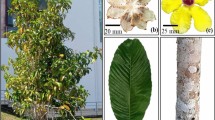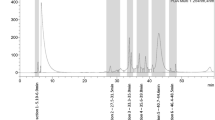Abstract
Cassia (C.) surattensis Burm. f. (Leguminosae) is a flowering plant that has been traditionally used in many countries for food and medicinal purposes. The present study was conducted to determine in vitro cytotoxicity and anti-genotoxic activity of the seed extract of C. surattensis. The cytotoxic and anti-genotoxic activities were evaluated against Vero cell line using 3-(4,5-dimethylthiazol-2-yl)-2,5-diphenyltetrazolium bromide (MTT) and comet assays. In vitro cytotoxicity evaluation demonstrated that seed extract of C. surattensis was non-cytotoxic against the Vero cells. The 50 % cytotoxic concentration (CC50) value from MTT cytotoxicity assay was 332.87 µg/ml. The seed extract of C. surattensis exhibited strong inhibitory effects against H2O2-mediated DNA damage in Vero cells as observed in Comet assay. The presence of antioxidant activity in the seed extract was associated with the antigenotoxic property of C. surattensis. In summary, the present study demonstrated an efficient antigenotoxic property of C. surattensis, which is significant for future investigation for human applications.








Similar content being viewed by others
References
Pourmorad F, Hosseinimehr S, Shahabimajd N (2006) Antioxidant activity, phenol and flavonoids contents of some selected Iranian medicinal plants. Afr J Biotechnol 5:1142–1145
Gupta VK, Sharma SK (2006) Plants as natural antioxidants. Nat Prod Radiance 5:326–333
Gil MI, Ferreres F, Tomás-Barberán FA (1999) Effect of postharvest storage and processing on the antioxidant constituents (flavonoids and vitamin C) of fresh-cut spinach. J Agric Food Chem 47:2213–2217
Agbor AG, Ngogang YJ (2005) Toxicity of herbal preparations. Cameroon J Ethnobot 1:23–28
Ferguson LR (1994) Antimutagens as cancer chemopreventive agents in the diet. Mutat Res 307:395–410
Viegas C Jr, Bolzani VS, Furlan M, Barreiro EJ, Young MCM, Tomazela D, Eberlin MN (2004) Further bioactive piperidine alkaloids from the flowers and green fruits of Cassia spectabilis. J Nat Prod 67:908–910
Perry LM (1980) Medicinal plants of east and southeast Asia. MIT Press, The Cambridge, pp 210–211
Burkill IH (1935) A dictionary of the economic products of the Malay Peninsula. Malaysia, Kuala Lumpur: Government of Malaysia and Singapore, Ministry of Agriculture and Cooperatives
Sangetha S, Zuraini Z, Sasidharan S, Suryani S (2008) Free radical scavenging activity of Cassia spectabilis and Cassia fistula. Int J Nat Eng Sci 2:111–112
Sangetha S, Zuraini Z, Sasidharan S, Suryani S (2008) Antibacterial, antifungal and cytotoxic activities of Cassia spectabilis. Asian J Pharm Clin Res 1:17–20
Arulmozhi DK, Veeranjaneyulu A, Bodhankar SL (2004) Neonatal streptozotocin-induced rat model of Type 2 diabetes mellitus: a glance. Indian J Pharmacol 36:217–221
Mosmann T (1983) Rapid colorimetric assay for cellular growth and survival: application to proliferation and cytotoxicity assays. J Immunol Methods 65:55–63
Singh NP, McCoy MT, Tice RR, Schneider EL (1988) A simple technique for quantitation of low levels of DNA damage in individual cells. Exp Cell Res 175:184–191
McKim JM Jr (2010) Building a tiered approach to in vitro predictive toxicity screening: a focus on assays with in vivo relevance. Comb Chem High Throughput Screen 13:188–206
Plumb JA, Milroy R, Kaye SB (1989) Effects of the pH dependence of 3-(4,5-dimethylthiazol-2-yl)-2,5-diphenyl—tetrazoliumbromide-formazan absorption on chemosensitivity determined by a novel tetrazolium—based assay. Cancer Res 49:4435–4440
Hong HS, Maezawa I, Yao N, Xu B, Diaz-Avalos R, Rana S, Hua DH, Cheng RH, Lam KS, Jin LW (2007) Combining the rapid MTT formazan exocytosis assay and the MC65 protection assay led to the discovery of carbazole analogs as small molecule inhibitors of abetaoligomer-induced cytotoxicity. Brain Res 1130:223–234
FDA (2006) Guidance for industry antiviral product development—conducting and submitting virology studies to the Agency. USA, Silver Spring, MD: US Department of Health and Human Services. Food and Drug Administration Center for Drug Evaluation and Research (CDER)
Zirihi GN, Mambu L, Guédé-Guina F, Bodo B, Grellier P (2005) In vitro antiplasmodial activity and cytotoxicity of 33 West African plants used for treatment of malaria. J Ethnopharmacol 98:281–285
Aroke SA, Lynd JM, Jacobus NE (2013) Evaluation of pharmacological activities, cytotoxicity and phenolic composition of four Maytenus species used in southern African traditional medicine to treat intestinal infections and diarrhoeal diseases. BMC Complement Altern Med 13:100
Sumathy V, Zuraini Z, Sasidharan S (2011) In vivo toxicity study of Cassia surattensis flower extract. Res J Pharm Biol Chem Sci 2:607–617
Claudia MM, Sara ES, Franco E, Carola S, Liliana S, María F, Lucía EA (2012) Antibacterial and cytotoxic activities of Acacia aroma extracts. Emir J Food Agric 24:308–313
Nabil BSA, Zyed R, Faten N, Nidhal S, Mahjoub A (2012) Evaluation of dimethylthiazol diphenyl tetrazolium bromide and propidium iodide inclusion assays for the evaluation of cell viability by flow cytometry. J Appl Pharm Sci 2:10–14
Scassellati SG, Villarini M, Moretti M (1999) Antigenotoxic properties of Terminalia arjuna bark extracts. J Environ Pathol Toxicol Oncol 18:119–125
Meneghini R, Martins EL (1993) Hydrogen peroxide and DNA damage. In: Halliwell B, Aruoma OI (eds) DNA and free radicals. Ellis Horwood, New York, pp 83–93
Kruszewski M, Green MHL, Lowe JE, Szumiel I (1994) DNA strand breakage, cytotoxicity and mutagenicity of hydrogen peroxide treatment at 4 °C and 37 °C in L5178Y sublines. Mutat Res 308:233–241
Henzler T, Steudle E (2000) Transport and metabolic degradation of hydrogen peroxide in Chara corallina: model calculations and measurements with the pressure probe suggest transport of H2O2 across water channels. J Exp Bot 51:2053–2066
Jaruga P, Dizdaroglu M (1996) Repair of products of oxidative DNA base damage in human cells. Nucleic Acids Res 24:1386–1394
Wang J, Xiong S, Xie C, Markesbery WR, Lovell MA (2005) Increased oxidative damage in nuclear and mitochondrial DNA in Alzheimer’s disease. J Neurochem 93:953–962
Rosen GM, Rauckman EJ (1984) Spin trapping of superoxide and hydroxyl radical. In: Packer L (ed) Oxygen radicals in biological systems. Methods in enzymology, vol 105. J Orlando, San Diego, pp 198–209
Gill T, Kumar M, Kumar S, Kaur S (2011) DNA-protective effect of extract/fractions from Centella asiatica (L.) Urban in single cell gel electrophoresis assay. Spatula DD 1:207–212
Jothy SL, Yeng C, Kanwar JR, Sasidharan S (2013) Evaluation of the genotoxic potential against—radical-mediated DNA damage and acute oral toxicity of standardized extract of Polyalthia longifolia Leaf. Evid Based Complement Altern Med 2013:13
Kapiszewska M, Soltys E, Visioli F, Cierniak A, Zajac G (2005) The protective ability of the Mediterranean plant extracts against the oxidative DNA damage. The role of the radical oxygen species and the polyphenol content. J Physiol Pharmacol 56:183–197
Duthie SJ, Collins AR, Duthie GG, Dobson VL (1997) Quercetin and myricetin protect against hydrogen peroxide-induced DNA damage (strand breaks and oxidised pyrimidines) in human lymphocytes. Mutat Res 393:223–231
Aherne SA, O’Brien NM (1999) Protection by the flavonoids myricetin, quercetin, and rutin against hydrogen peroxide-induced DNA damage in Caco-2 and Hep G2 cells. Nutr Cancer 34:160–166
Acknowledgments
This work was partly supported by HIR MoE Grant UM.C/625/1/HIR/MOHE/MED/16/5, UM.C/625/1/HIR/MOE/DENT/09 and UMRG (No. RG454-12HTM). Thanks are due to Mr Shunmugam a/l Vellosamy of the School of Biological Sciences, USM for authentication of the plant species. Authors are also thankful to Yasumura and Kawakita of Chiba University, Japan for initiating the Vero cell line from the kidney of a normal adult African green monkey.
Author information
Authors and Affiliations
Corresponding author
Ethics declarations
Conflict of interest
The authors declare that they have no conflict of interest.
Rights and permissions
About this article
Cite this article
Uthaya Kumar, U., Jothy, S.L., Kavitha, N. et al. Genoprotection and Cytotoxicity of Cassia surattensis Seed Extract on Vero Cell Evaluated by Comet and Cytotoxicity Assays. Proc. Natl. Acad. Sci., India, Sect. B Biol. Sci. 88, 313–320 (2018). https://doi.org/10.1007/s40011-016-0761-8
Received:
Revised:
Accepted:
Published:
Issue Date:
DOI: https://doi.org/10.1007/s40011-016-0761-8




